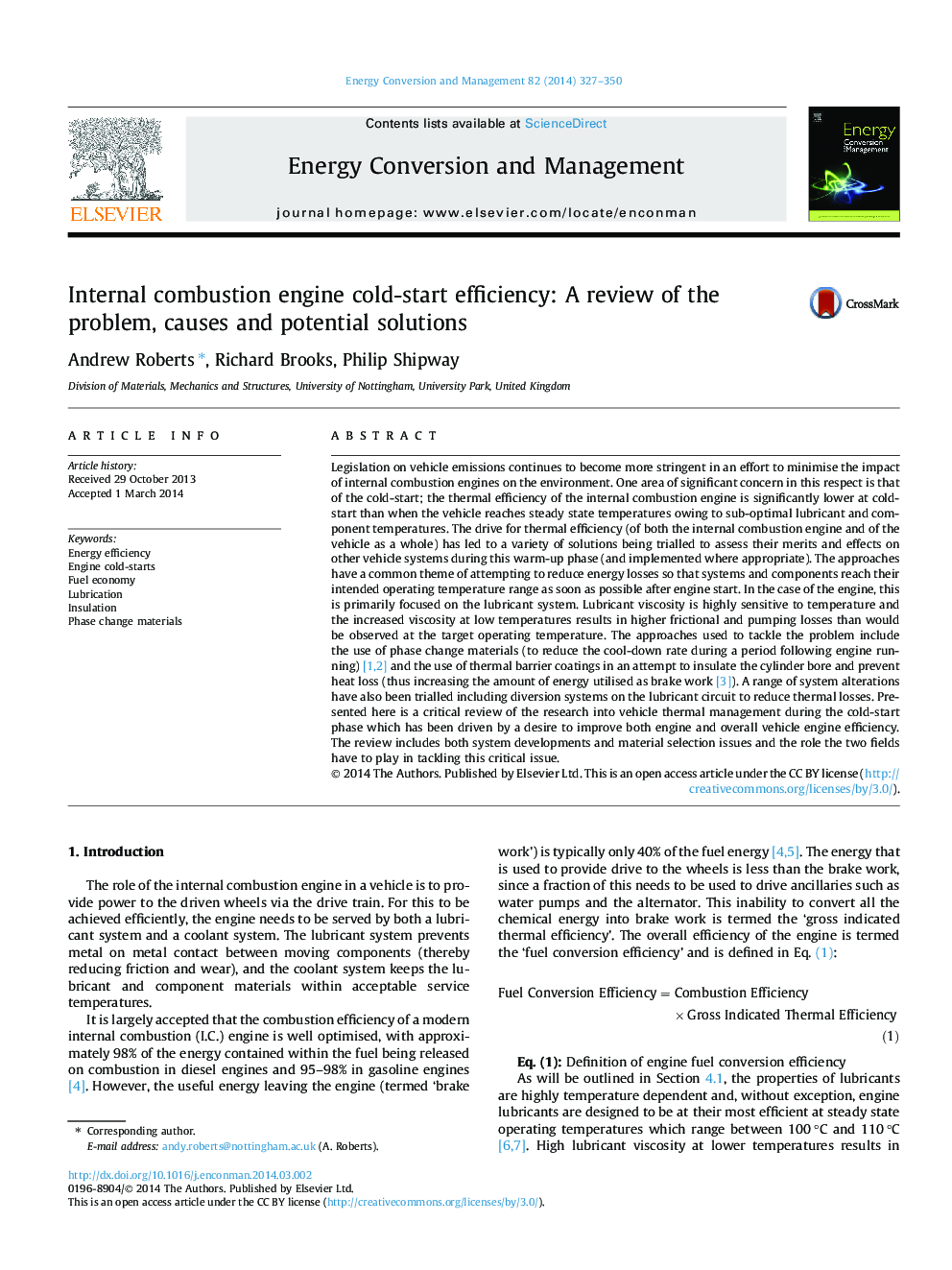| کد مقاله | کد نشریه | سال انتشار | مقاله انگلیسی | نسخه تمام متن |
|---|---|---|---|---|
| 7164928 | 1462880 | 2014 | 24 صفحه PDF | دانلود رایگان |
عنوان انگلیسی مقاله ISI
Internal combustion engine cold-start efficiency: A review of the problem, causes and potential solutions
ترجمه فارسی عنوان
راندمان خاموش شدن موتور احتراق داخلی: بررسی مشکل، علل و راه حل های بالقوه
دانلود مقاله + سفارش ترجمه
دانلود مقاله ISI انگلیسی
رایگان برای ایرانیان
کلمات کلیدی
بهره وری انرژی، موتور سرد شروع می شود، اقتصاد سوخت، روانکاری عایق، مواد تغییر فاز،
ترجمه چکیده
قوانین مربوط به انتشار خودروها در تلاش برای به حداقل رساندن تاثیر موتورهای احتراق داخلی بر محیط زیست سخت تر می شود. یکی از زمینه های مهم نگرانی در این رابطه این است که شروع سرما؛ بازده حرارتی موتور احتراق داخلی به میزان قابل توجهی پایین تر از زمانیکه خودرو به دمای پایدار با توجه به درجه حرارت پایین و روانکاری مطلوب می رسد، پایین تر است. درایو برای راندمان حرارتی (موتور احتراق داخلی و کل وسیله نقلیه) منجر به راه حل های مختلفی شده است که برای ارزیابی شایستگی ها و اثرات آنها بر روی سیستم های دیگر خودرو در طول این مرحله گرم شدن منجر شده (و در صورت لزوم اجرا می شود ) این رویکردها یک موضوع مشترک برای تلاش برای کاهش تلفات انرژی است تا سیستم ها و اجزای سازنده در محدوده دما در نظر گرفته شده خود را در اسرع وقت پس از شروع موتور، رسیدن به محدوده دما در نظر گرفته شوند. در مورد موتور، این عمدتا بر سیستم روانکاری تمرکز دارد. ویسکوزیته روان کننده به درجه حرارت بسیار حساس است و ویسکوزیته افزایش یافته در دماهای پایین منجر به افت خزش و پمپاژ نسبت به دمای عملیاتی هدف می شود. روشی که برای مقابله با این مشکل استفاده می شود عبارتند از استفاده از مواد تغییر فاز (برای کاهش سرعت خنک شدن در طول دوره ای که در زیر موتور در حال اجرا است) [1]، [2] و استفاده از پوشش های حرارتی در تلاش برای انحلال سیلندر سوراخ کردن و جلوگیری از از دست رفتن حرارت (به این ترتیب افزایش مقدار انرژی مورد استفاده در کار ترمز [3]). تعدادی از تغییرات سیستم نیز مورد آزمایش قرار گرفته است از جمله سیستم های انحراف در مدار روغن برای کاهش تلفات حرارتی. ارائه شده در اینجا یک بررسی بحرانی از تحقیق در مورد مدیریت حرارتی خودرو در مرحله فاز سرد است که توسط تمایل به بهبود موتور و کل موتور بهره وری موتور رانده شده است. این بررسی شامل توسعه سیستم و مسائل انتخاب مواد و نقش دو مؤلفه در حل این مسئله مهم می باشد.
موضوعات مرتبط
مهندسی و علوم پایه
مهندسی انرژی
انرژی (عمومی)
چکیده انگلیسی
Legislation on vehicle emissions continues to become more stringent in an effort to minimise the impact of internal combustion engines on the environment. One area of significant concern in this respect is that of the cold-start; the thermal efficiency of the internal combustion engine is significantly lower at cold-start than when the vehicle reaches steady state temperatures owing to sub-optimal lubricant and component temperatures. The drive for thermal efficiency (of both the internal combustion engine and of the vehicle as a whole) has led to a variety of solutions being trialled to assess their merits and effects on other vehicle systems during this warm-up phase (and implemented where appropriate). The approaches have a common theme of attempting to reduce energy losses so that systems and components reach their intended operating temperature range as soon as possible after engine start. In the case of the engine, this is primarily focused on the lubricant system. Lubricant viscosity is highly sensitive to temperature and the increased viscosity at low temperatures results in higher frictional and pumping losses than would be observed at the target operating temperature. The approaches used to tackle the problem include the use of phase change materials (to reduce the cool-down rate during a period following engine running) [1], [2] and the use of thermal barrier coatings in an attempt to insulate the cylinder bore and prevent heat loss (thus increasing the amount of energy utilised as brake work [3]). A range of system alterations have also been trialled including diversion systems on the lubricant circuit to reduce thermal losses. Presented here is a critical review of the research into vehicle thermal management during the cold-start phase which has been driven by a desire to improve both engine and overall vehicle engine efficiency. The review includes both system developments and material selection issues and the role the two fields have to play in tackling this critical issue.
ناشر
Database: Elsevier - ScienceDirect (ساینس دایرکت)
Journal: Energy Conversion and Management - Volume 82, June 2014, Pages 327-350
Journal: Energy Conversion and Management - Volume 82, June 2014, Pages 327-350
نویسندگان
Andrew Roberts, Richard Brooks, Philip Shipway,
